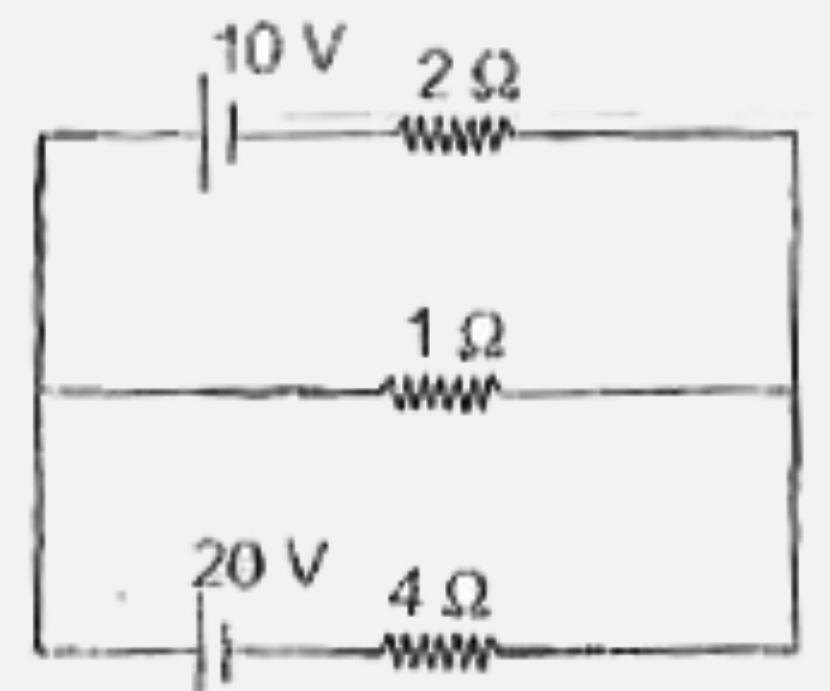A parallel combination of three resistors takes a current of 5 A from a 20 V supply. If the resistors are of 10Ωand8Ω find the value of the third resistor.
To find the value of the third resistor in a parallel combination of three resistors, we can follow these steps:
Step 1: Understand the given information
We have a parallel combination of three resistors (R1, R2, and R3) connected to a 20 V power supply, and the total current flowing through the circuit is 5 A. The values of R1 and R2 are given as 10 Ω and 8 Ω, respectively.
Step 2: Calculate the equivalent resistance (R_eq)
Using Ohm's Law, we can find the equivalent resistance of the circuit. Ohm's Law states that:
V=I×R
Rearranging this gives:
R=VI
Substituting the values:
Req=20V5A=4Ω
Step 3: Use the formula for resistors in parallel
The formula for the equivalent resistance of resistors in parallel is:
1Req=1R1+1R2+1R3
Substituting the values we know:
14=110+18+1R3
Step 4: Calculate the individual terms
First, we need to calculate the fractions:
- For R1=10Ω:
110=0.1
- For R2=8Ω:
18=0.125
Step 5: Combine the fractions
Now, we can combine the fractions:
14=0.1+0.125+1R3
Calculating the sum of 0.1+0.125:
0.1+0.125=0.225
Step 6: Rearrange to find 1R3
Now we can rearrange the equation to solve for 1R3:
1R3=14−0.225
Calculating 14:
14=0.25
Now substituting:
1R3=0.25−0.225=0.025
Step 7: Calculate R3
Now, we take the reciprocal to find R3:
R3=10.025=40Ω
Final Answer
The value of the third resistor R3 is 40 Ω.
---
We have a parallel combination of three resistors (R1, R2, and R3) connected to a 20 V power supply, and the total current flowing through the circuit is 5 A. The values of R1 and R2 are given as 10 Ω and 8 Ω, respectively.
Using Ohm's Law, we can find the equivalent resistance of the circuit. Ohm's Law states that:
V=I×R
Rearranging this gives:
R=VI
Substituting the values:
Req=20V5A=4Ω
The formula for the equivalent resistance of resistors in parallel is:
1Req=1R1+1R2+1R3
Substituting the values we know:
14=110+18+1R3
First, we need to calculate the fractions:
- For R1=10Ω:
110=0.1
- For R2=8Ω:
18=0.125
Now, we can combine the fractions:
14=0.1+0.125+1R3
Calculating the sum of 0.1+0.125:
0.1+0.125=0.225
Now we can rearrange the equation to solve for 1R3:
1R3=14−0.225
Calculating 14:
14=0.25
Now substituting:
1R3=0.25−0.225=0.025
Now, we take the reciprocal to find R3:
R3=10.025=40Ω
The value of the third resistor R3 is 40 Ω.
Topper's Solved these Questions
- CURRENT ELECTRICITYBook:MODERN PUBLICATIONChapter:CURRENT ELECTRICITYExercise:CONCEPTUAL QUESTIONS
Explore 35 Videos
- CURRENT ELECTRICITYBook:MODERN PUBLICATIONChapter:CURRENT ELECTRICITYExercise:TOUGH AND TRICKY PROBLEMS
Explore 23 Videos
- CURRENT ELECTRICITYBook:MODERN PUBLICATIONChapter:CURRENT ELECTRICITYExercise:Chapter Practice Test
Explore 15 Videos
- ATOMS Book:MODERN PUBLICATIONChapter:ATOMS Exercise:Chapter Practice Test
Explore 16 Videos
- DUAL NATURE OF RADIATION AND MATTER Book:MODERN PUBLICATIONChapter:DUAL NATURE OF RADIATION AND MATTER Exercise:CHAPTER PRACTICE TEST
Explore 15 Videos
Similar Questions
A parallel combination of three resistors takes a current of 7.5A from a 30V supply. If the two resistors are 10Ωand12Ω, find third one.
View SolutionA parallel combination of three resistors takes a current of 7.5 A from a 30 V supply. If the two resistors are 10Ω and 12Ω, find the third one.
View SolutionA parallel combination of three resistors take a currect of 7.5A from 30V supply. If the two resistor are 10Ω and 12Ω. find the third one.
View SolutionA series combination of three resistors takes current 2 A from a 24 V supply. If the resistors are in the ratio 1:2:3. Find the values of the unknown resistors.
View SolutionThe series combination of two batteries both of the same emf 10 V, but different internal resistance of 20Ω and 5Ω is connected to the parallel combination of two resistors 30Ω and RΩ . The voltage difference across the battery of internal resistance 20Ω is zero, the value of R(in Ω) is __________.
View SolutionThe series combination of two batteries, both of the same emf 10 V, but different internal resistance of 10Ω and 5Ω is connected to the parallel combination of two resistors 30Ω and RΩ . The voltage difference across the battery of internal resistance 10Ω is zero, the value of R (in Ω ) is : _________.
View SolutionA resistor of 5Ω is connected in series with a parallel combination of a number of resistors each of 5Ω. If the total resistance of the combination is 6Ω , how many resistor are in parallel?
View SolutionA combination consists of three resistors in series. Four similar sets are connected in parallel. If the resistance of each resistor is 2Ω, find the resistance of this combination.
View SolutionThe value of current through 2Ω resistor is

View SolutionFind the current through 12Ω resistor in

View Solution

